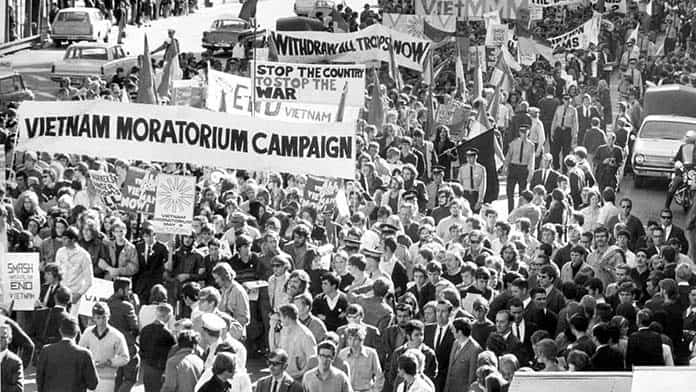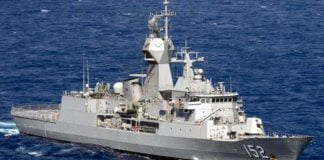On 8 May 1970, fifty years ago this month, 200,000 people joined the first national Moratorium march against the Vietnam War. These were most than just street marches. The main protests were held on a Friday, with tens of thousands of workers striking or leaving work to attend.
They were the culmination of years of anti-war organising, and showed that large numbers were prepared to take disruptive action to bring the war to an end.
The largest demonstration was in Melbourne, where 100,000 marched down Bourke St, intending to hold a sit down on the road when they reached Elizabeth St. The crowd was so big that many had to sit down before they got there.
“I remember it being the most enormous thing I’d ever seen, it stretched all the way up Bourke St, you couldn’t move, the rally was just so vast,” socialist and historian Phil Griffiths told Solidarity.
In Sydney 30,000 joined the Moratorium, along with 8000 in Brisbane and thousands more in other cities.

Hall Greenland, who spoke at the Sydney rally, told Solidarity, “I was at Sydney University at the time and was part of organising essentially a general strike on the day at the university, there was a huge mass rally on the front lawn and then we marched down to the Town Hall.
“The day itself was basically young people and militant workers. The building sites and the wharves, and a lot of schools as well, closed and thousands of them marched.”
Phil Griffiths explained, “The reason Melbourne’s rally was so much bigger was because the trade union movement said, we are out on strike against the war. There were massive union contingents. I remember some of them marching from Trades Hall to the rally.”
The 27 “rebel unions” who had split from the Victorian Trades Hall Council appointed a full-time organiser who set up workplace meetings to build support. Another six unions still affiliated to Trades Hall also backed the mobilisation.
Unions paid for an ad in Melbourne’s Sun newspaper that encouraged unionists to stop work on the day to attend.
Across the country strikes to join the Moratorium included a, “national 24-hour stopwork by seamen on ships in ports around the Australian coast, and shorter stops by watersiders in Sydney, Brisbane and various other ports and by big numbers of building, metal and other workers,” Tribune, the newspaper of the Communist Party, wrote at the time.
“Between half and two-thirds of people at the weekday rallies were workers,” according to Phil Griffiths.
“They drew everyone in. I was working at a conservative high school at the time of the second Moratorium in 1970. Around half the teachers struck.”
Anti-war movement
The Moratoriums are remembered as the high point of the movement against the Vietnam War. But they could not have happened without the previous five years of organising, led at first by small numbers of student radicals and left-wing unions.
In the early 1960s, at the height of the Cold War, Australia was still a very conservative society. In 1965 Robert Menzies’ Liberal government introduced conscription for young men turning 20 years old each year through a ballot. Initially there was overwhelmingly public support for sending troops to Vietnam.
Student activists and others began to campaign against conscription. Some of the first protests came from left-wing unions. In Melbourne 2500 dock workers walked off the job against the decision to send troops and in Brisbane 500 demonstrated outside the US consulate.
In May 1966 seafarers refused to work on the Boonaroo, which the government had chartered to carry military supplies to Vietnam. But they were forced to back down, when other unions were unwilling to support their stand.
Labor opposed both the war and conscription at the 1966 election but was soundly defeated. In response, sections of the anti-war movement turned to more radical tactics in an effort to force change.
Students at Monash University caused uproar in 1967 by declaring their support for the resistance fighters, collecting money on campus for the Vietnamese National Liberation Front.
A Draft Resisters Movement was formed, to explicitly go beyond “conscientious objection” and organise for 20-year-olds eligible for conscription to refuse to register, and instead go underground to defy the draft.
There was a significant divide in the movement between the new radical left that had exploded amongst students and young people, and the older left including the Communist Party and the Labor Left.
The new revolutionary left, including currents such as the Maoists, Trotskyists and anarchists, spearheaded the revolt on the university campuses and militant, civil disobedience actions against the war.
Initially the more moderate sections of the movement argued for vague slogans such as “peace now” or “stop the war, negotiate”, claiming this was the way to attract wider support for the movement, while the radicals demanded “Troops out now” and “Smash US imperialism.”
But, “by 1970 nobody opposed the demand for withdrawal of the troops, that became the central demand of the Moratorium,” according to Hall Greenland. This was, “at the level of demands, a victory for the more radical wing of the movement in Sydney… whereas the Communist Party and Labour Left had focused on abstract calls for peace in Vietnam or stop the bombing”.
Civil disobedience

“The first demo I went on as a 17-year-old student was a protest against [Melbourne City Council] bylaw 418, which prohibited handing out leaflets in the city. It was an attack on free speech,” explained Phil Griffiths.
The campaign began when students started handing out leaflets that advocated refusing to register for the draft, which was itself a criminal offence. There were regular protests over several months, with hundreds arrested and some jailed for refusing to pay fines.
“It was a civil disobedience action, we went down to the GPO and handed out leaflets.
“Jim Cairns, the Deputy Leader of the Federal Labor Party, turned up, handed out leaflets and got arrested. It was a deliberate action by Cairns. No Labor leader today would do that. You would never see anyone, even on the left, doing anything as radical as that,” he said.
“The response from Trades Hall was immediate. The Lord Mayor, Sir Maurice Nathan, was also the head of the Victorian Racing Committee. Trades Hall Council basically said, if you don’t drop the charges there won’t be a racing carnival. And they backed down.
“The council repealed the bylaw, which was a huge victory for organising and free speech.”
This showed the importance of “the combination of civil disobedience action, the involvement of significant figures in the political labour movement, and the trade union leadership”. The students’ radical action pushed others to take a stand and shifted the movement to the left.
Civil disobedience actions also helped to shift the mood in society and built wider opposition to the war. The movement radicalised as larger numbers of people were drawn into action against a government and political establishment determined to continue the war.
The impact of the students’ militancy coloured the Moratorium marches and the whole period.
“The atmosphere was absolutely one of confrontation in the lead up to the protest in May”, said Phil Griffiths. “There was clearly an attempt by government to intimidate people from going.
“Billy Snedden [who was the Federal Minister for National Service in charge of
conscription at the time] described the protesters as ‘political bikies pack-raping democracy’ and the Victoria Police said that they expected violence on the demo.
“There had been a lot of police violence against demonstrations in the previous period.”
On 4 July 1968 a rally of 4000 people tried to storm the US embassy in Melbourne in Commercial Road, South Yarra. There were pitched battles with police, who rode horses into the crowd at a full canter.
“The Maoists had organised to physically attack the building,” Phil remembers, “I don’t know if they actually smashed every window in the building, but that was the legend.”
“The year later I went on the 4 July protest. Police had barricaded Commercial Road, and had horses dispersing the demonstrators.”
“To add to the sense of menace [a few] days before the Moratorium rallies you had protesters shot down dead at Kent State University. So when the police said they expected violence, this is in the context of the National Guard shooting demonstrators at a university in America and killing four.”
But the scale of the turnout showed how far the public mood had shifted against the war—and the growing mood of radicalism and defiance.
The Vietnamese “Tet Offensive” in 1968 had also proven that the US was losing the war—despite continual lies from the US and Australian governments that everything was going well.
By 1969 a majority supported withdrawing troops.
The new radicalism against the war also began to feed into the trade union movement, leading to an increase in strikes and class struggle.
In 1969 one million workers went on strike in response to the jailing of union official Clarrie O’Shea. The strikes won his release and smashed the anti-union laws of the time, the penal powers, which had imposed large fines against industrial action.
This encouraged union leaders to throw their support further behind the anti-war movement.
The idea of the Moratoriums was to hold “a moratorium against business as usual”, halting work to shut down society and force an end to the war.
The term was borrowed from the US, where an enormous national Moratorium protest on 15 October 1969 drew 250,000 in New York and 100,000 in Washington.
The campaign for the Moratoriums in Australia began at the end of 1969 when an invite-only meeting of representatives from around the country was held.
At the federal election that year there had been a large swing towards the Labor Party, but the Liberals narrowly retained government. This gave a boost to opponents of the war, as it showed public opinion was turning against the government.
But it also meant the prospect of electoral change was closed over for the immediate future. So the Labor Party, trade union leaders and the Communist Party were more open to mobilising against the war on the streets.
There were sharp debates over the shape that the Moratorium protests would take between the radicals and the more moderate parts of the movement.
The student radicals pushed for mass meetings of activists to set the overall direction of the Moratorium campaign.
The most famous was held in February at the Richmond Town Hall in Melbourne where 500 activists met to discuss the Moratorium. There were similar mass meetings in other states.
Jim Cairns, the Federal Deputy Leader of the Labor Party, was elected chair of the Victorian Moratorium Committee and helped lead the march.
There were two further Moratorium marches, in September 1970 and June 1971. In December 1971 Liberal Prime Minister John Gorton announced the complete withdrawal of troops.
The US was also beginning to pull out its troops, but continued bombing Vietnam until 1975 when the US was finally defeated. The heroic resistance of the Vietnamese people combined with mass opposition to the war in the US had driven the superpower out of Vietnam. It was a massive blow to US imperialism.
The movement in Australia also succeeded in turning public opinion against the war and building political pressure to the point where the government was forced to give in.
The Moratoriums were a high point not just because of their size, but because they drew in the social power of organised workers. They showed how strike action was capable of paralysing society through stopping business as usual and disrupting the flow of profits.
Today, as we face the challenge of turning the student Climate Strikes into serious workers’ strikes, and of fighting the unemployment and wage cuts triggered by the coronavirus, there are rich lessons to learn.
By James Supple






